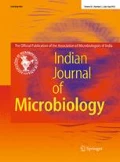Abstract
Rice ragged stunt disease caused leads to severe loss of rice yield. Recently, rice ragged stunt virus (RRSV) were found to be increasingly common in rice-growing regions of China and Vietnam. RRSV may cause problem by interacting with microRNAs (miRNAs) of host cells and the mechanism is not clear yet. In this study we identified 11 miRNAs in response to RRSV infection and predicted their possible targets to viral RNA segments (S1–S10) through the bioinformatics analysis. Interestingly, we found that Osa-miR-168b might bind to both the CDS region and 3′UTR of S5 and S8 and target eEF-1A to inhibit the activity of host cells to facilitate RRSV replication. These results suggest that miRNAs may be a potential target for developing rice against RRSV infection.




References
Wu J, Du Z, Wang C, Cai L, Hu M, Lin Q, Wu Z, Li Y, Xie L (2010) Identification of Pns6, a putative movement protein of RRSV, as a silencing suppressor. Virol J 7:335
Quito-Avila DF, Lightle D, Lee J, Martin RR (2012) Transmission biology of Raspberry latent virus, the first aphid-borne reovirus. Phytopathology 102:547–553
Khongnomnan K, Makkoch J, Poomipak W, Poovorawan Y, Payungporn S (2015) Human miR-3145 inhibits influenza A viruses replication by targeting and silencing viral PB1 gene. Exp Biol Med 240:1630–1639
Wilson RC, Doudna JA (2013) Molecular mechanisms of RNA interference. Annu Rev Biophys 42:217–239
Guo YE, Steitz JA (2014) Virus meets host microRNA: the destroyer, the booster, the hijacker. Mol Cell Biol 34:3780–3787
Cullen BR (2011) Viruses and microRNAs: RISCy interactions with serious consequences. Genes Dev 25:1881–1894
Zhang Z, Yu J, Li D, Zhang Z, Liu F, Zhou X, Wang T, Ling Y, Su Z (2010) PMRD: plant microRNA database. Nucleic Acids Res 38:D806–D813
Zheng Z, Ke X, Wang M, He S, Li Q, Zheng C, Zhang Z, Liu Y, Wang H (2013) Human microRNA hsa-miR-296-5p suppresses enterovirus 71 replication by targeting the viral genome. J Virol 87:5645–5656
Wang L, Qin Y, Tong L, Wu S, Wang Q, Jiao Q, Guo Z, Lin L, Wang R, Zhao W, Zhong Z (2012) MiR-342-5p suppresses coxsackievirus B3 biosynthesis by targeting the 2C-coding region. Antivir Res 93:270–279
Jopling CL, Schütz S, Sarnow P (2008) Position-dependent function for a tandem microRNA miR-122-binding site located in the hepatitis C virus RNA genome. Cell Host Microbe 4:77–85
Mohr I, Sonenberg N (2012) Host translation at the nexus of infection and immunity. Cell Host Microbe 12:470–483
Songbai Z, Zhenguo D, Liang Y, Zhengjie Y, Kangcheng W, Guangpu L, Zujian W, Lianhui X (2013) Identification and characterization of the interaction between viroplasm-associated proteins from two different plant-infecting reoviruses and eEF-1A of rice. Arch Virol 158:2031–2039
Acknowledgments
This work was supported by the open project fund of State Key Laboratory of Hybrid Rice (Wuhan University, No. KF201405), the National Natural Sciences Foundation of China (Nos. 81371790 and 81171577), and the Translational Medical Research Fund of Wuhan University School of Medicine.
Author information
Authors and Affiliations
Corresponding author
Electronic supplementary material
Below is the link to the electronic supplementary material.
Figure S1
These predicted miRNAs and their targets by another bioinformatics software RNAhybrid. (TIFF 9776 kb)
Rights and permissions
About this article
Cite this article
Zhang, Y., Chen, X., Yang, F. et al. miRNA: A Novel Link Between Rice Ragged Stunt Virus and Oryza sativa . Indian J Microbiol 56, 219–224 (2016). https://doi.org/10.1007/s12088-016-0572-x
Received:
Accepted:
Published:
Issue Date:
DOI: https://doi.org/10.1007/s12088-016-0572-x

